Tomatoes are one of the most budget-friendly, multi-purpose, and highest yielding vegetables you can grow. Because they are quite hardy and can grow in a variety of conditions, they are also one of the easiest. This ultimate guide to growing tomatoes will be your favorite resource when it comes to gardening because it will share with you all of the tips and tricks you need to know to grow a bountiful tomato harvest.
Whether you are looking to feed just yourself or the whole neighborhood, whether you want to grow basic cherry tomatoes or heirlooms, or whether you have a green thumb or not, this guide will help you identify your needs and adapt for success.Take a look at our ultimate guide to growing tomatoes and see how you can become an expert when it comes to growing this tasty and practical vegetable! We will cover a whole slew of topics, including what you will need to get started, tomatoes by size, how to grow plants from seeds and seedlings, how to grow tomatoes in containers, troubleshooting, and so much more.
10 Reasons to Grow Tomatoes:
First, let’s look at some of the reasons why you should grow tomatoes. Growing tomatoes comes with many benefits, and we are going to share those here. Take a look at our favorite reasons to grow tomatoes, and see if you aren’t convinced to add tomatoes to your garden this year.1. Tomato plants give you bang for your buck.
Did you know that you can get a minimum of 10 pounds of tomatoes per plant? Since a tomato seedling will cost around $1, that is like paying only ten cents per pound! With tomato plants, you spend a little and get a lot in return. Read our tomato growth tips here with video to get 50-80 pounds of tomatoes from each plant!
2. Tomatoes can be grown in any space.
If you are concerned about a small growing space, there is no need to panic. Tomatoes can grow in just about any space. You only need about one square foot per plant if grown in the ground. If you don’t have ground space, smaller varieties like cherry tomatoes can be grown in pots and even hanging baskets.
3. Tomato plants are forgiving.
Is your soil less than perfect? Does your growing region get less than ideal weather? Perhaps you are too busy to weed every single day. Whatever the case may be, tomato plants, in general, are quite hardy and won’t fail if conditions aren’t just right.
4. Tomatoes are nutrient-rich.
Tomatoes are excellent for your diet. They are high in vitamins and minerals, including lycopene. They offer not just flavor, but health benefits as well. Adding tomatoes to your diet can give your body the nutrients it craves.
5. You have many options when it comes to preserving your harvest.
So what should you do with your bountiful harvest? When it comes to tomatoes, you have many options. You can freeze, dry, can turn into a sauce or even stew. You don’t need to worry about your harvest going to waste, as there are many ways to preserve your tomatoes for later.
6. Growing tomatoes takes minimal supplies.
You don’t need fancy gardening equipment to enjoy growing tomatoes. All you need is some nutrient-rich soil, a water source, and some type of support such as a stake or a tomato cage. Both stakes and tomato cages can typically be purchased for under $3.
7. You can harvest seeds from your tomatoes.
Did you know that you can get free tomato seeds from your tomato harvest? Feel free to save the seeds from your tomatoes to grow future plants. As long as the seeds are kept in a cool and dry place, they will be ready for planting.
8. The growing season for tomatoes is lengthy.
In most growing areas, tomatoes will be in harvest from mid-July to early September. That is around six weeks of harvesting! You can always consider planting your tomatoes in succussion so you can enjoy a fresh crop even longer.
9. Tomato plants are fuss-free.
Tomato plants don’t require a great deal of fuss. As long as they are kept watered and supported, they will do their thing! Tomato plants don’t need a great deal of daily care and monitoring until the harvest starts to come in.
10. There are numerous varieties to choose from.
When it comes to tomato varieties, you have several dozen to choose from. You can select all different sizes, colors, and even flavors. Take the time to decide which tomato variety works for you and your needs and plan accordingly.
12 Tomato Varieties to Try Right Now
Now that you know all of the benefits of planting tomatoes let’s look at what some of your planting options are. When it comes to tomatoes, you have dozens of varieties to pick from, and this might get confusing. Here we will look at some of the most popular and user-friendly tomato plants to choose from.1. Super Sweet 100
Super Sweet 100’s are cherry-sized tomatoes that grow in a variety of colors such as red, mauve, purple, and shades of gold. They are very sweet and ideal for snacking just as they are. They grow well in containers and small spaces, even hanging baskets. You will quickly get 100’s of tiny tomatoes per plant. Many gardeners love planting these because they are perfect for picking off the plant and enjoying right in the garden.
2. Better Boy
Better Boy tomatoes are what most people think of when they think of traditional tomatoes. They are bright red, medium to large, and ideal for slicing. They work well in salads and are great for canning.
3. Yellow Pear
These tomatoes are called yellow pear because they take on a beautiful golden hue and are pear-shaped. They are smaller in size than traditional tomatoes, making them ideal for container gardening. They also offer color and sweetness to your salads.
4. Early Girl
Early Girl tomatoes get their name because they do, in fact, grow earlier than most tomato varieties. If you want to enjoy your harvest sooner, this type of tomato is ideal. These tomatoes can easily weigh over a pound each, and are great for slicing!
5. Black Krim
If you want to try something unique, Black Krim tomatoes are it. They are large and dark purple. They sure don’t look like traditional tomatoes! But don’t worry, they are still rich in flavor and can add an exciting spin to your salads and stews.
6. Cherokee Purple
Many gardeners like growing Cherokee purple simply because of the gorgeous color! They are smaller in size, larger than cherry tomatoes but smaller than most heirloom varieties. This makes them ideal for container gardening.
7. Beefsteak
If you are a fan of the classics, beefsteak tomatoes are for you. They are rich and juicy, perfect for slicing, salads, and canning. They can grow over a pound in size, so ideal for ground growing where land is plentiful. This tomato variety can grow massive in size, making them fun to grow, and weigh, to see which one is the biggest of them all!
8. Black Cherry
Black cherry tomatoes are much like other cherry tomatoes in the fact that they are petite and sweet. They do well in pots as well as hanging baskets, and one plant can yield dozens of bite-sized tomatoes. They are excellent for adding to vegetable trays and using in appetizers.
9. Chocolate Stripe
These tomatoes get their name from their coloring, which is a vibrant red with dark purple striping. An heirloom variety, they add color to any meal and grow medium in size. They are a tad sweet in their flavoring as well, making them a favorite amongst tomato gardeners.
10. Dixie Golden
These gorgeous golden tomatoes can grow to a pound or so in size and have a sweet flavor. If you like tomatoes on the more delicious, sugary side, Dixie Goldens are perfect for you. Just their color alone makes them adored by tomato gardeners, and worth looking into.
The Best Tomato Varieties by Size:
Your needs and amount of growing space will determine what size tomatoes you can grow. Different sized tomatoes offer different perks, so it is important to know ahead of time the potential of each plant. Here are the best tomato varieties broken down by size, so you can be more informed when you head to the greenhouse.5 of the Best Tiny Tomato Varieties:
Tiny tomato varieties are ideal for small spaces, containers, and hanging baskets. Here are 5 of the best small tomato varieties perfect for the person who is limited on space AND who loves to snack on tomatoes! One plant can yield several dozen tiny tomatoes, so these plants give you bang for your buck!
1. Super Sweet 100’s
2. Napa Grape Tomatoes
3. Sungold
4. Tiny Tim
5. Honeybunch Tomatoes
5 of the Best Small Tomato Varieties:
Small tomato varieties are also ideal for small spaces and containers but are too heavy for hanging baskets. They have a bit more meat on them than tiny tomatoes, so they are suitable for use in basic salads and soups, or recipes that require sliced or diced tomatoes. Here are 5 of the best small tomato varieties.
1. Roma
2. Gardener’s Delight
3. McDreamy]
4. Campari
5. Yellow Pear Tomatoes
5 of the Best Medium Tomato Varieties:
Medium tomato varieties do well in large and roomy containers or when planted directly into your gardening space. Medium tomato varieties are meaty, so they are ideal for soups, salads, stews, canning, and of course, sauces. Here are 5 of the best medium tomato varieties.
1. Early Girl
2. Alicante
3. Granadero
4. Green Zebra
5. Japanese Black
5 of the best Large Tomato Varieties:
Large tomato varieties will do best if allowed to grow directly in your growing space. These tomatoes are typically a pound or larger in size and can get quite massive. They are ideal for sandwich slices, soups, marinades, and sauces since they have a great deal of meat to them. Here are
1. Better Boy
2. Cherokee Purple
3. Dixie Golden
4. Bucking Bronco
5. Pink Beefsteak
7 Ways to Save Money on your Tomato Garden:
Tomatoes are already a frugal vegetable to grow, but there are still some easy ways to save money on your next planting. Take a look at these seven ways to save money on your tomato garden, and see how easy it can be to grow the tomatoes you love for less.1. Repurpose items for stakes. - The larger the tomato variety, the more important it is you have stakes to support your plants. Stakes will prevent the stems from snapping when the tomatoes get heavy and put pressure on the stems. You can buy tomato cages and plant stakes, but certain household items can be repurposed to do the job. Some household items you can use for stakes and support include sturdy twigs, scrap wood, yardsticks, chicken wire, and pieces from wood pallets.
2. Make your own compost. - Compost is a great way to keep your soil nutrient-rich and will help your tomato plants thrive. You can make your own compost when you simply save your kitchen scraps. Items such as fruit peels, vegetable peels, eggshells, coffee grounds, scrap paper, and even leftover pasta can be added to your compost pile. Simply keep a pile and often stir to keep the air circulating, so the items break down into black soil. You can view our diy compost bins to get started on setting up a compost station.
3. Make your own plant food. - There is no need to buy expensive plant food when you can feed your tomatoes for free. Applying eggshells around the plant can help feed the soil and give it a nutrient boost!
4. Use DIY pest repelling methods. - Over counter pest repelling sprays are expensive and full of chemicals. Try making your own by mixing 2 cups of water and a tablespoon of dish soap. Shake well and apply to the areas where pests seem to be a problem.
5. Save your seeds. - If there is a tomato variety you are really fond of, save seeds from the tomatoes to grow future plants. Store the seeds in a cool and dry place so you can plant them next year. This is a great way to get FREE plants. Just be sure to label the seeds, so you know which plants are which.
6. Seed swap. - If you grew Chocolate Stripe tomatoes and your neighbor grew Beefsteak, see if you can seed swap. Simply save some of your seeds and have them save some of theirs. You can then trade seeds and grow multiple varieties the following season.
7. Collect rainwater. - Tomatoes need at least two solid inches of water per week. Instead of turning on the hose, try using a rain barrel. You can find an online tutorial to make your own for cheap, or on a simpler scale, get into the habit of collecting rainwater in containers for quick waterings.
12 Items you Need for the Perfect Tomato Garden:
Before you start growing, you want to make sure you have all of the items you need on hand and ready! Having the right gardening supplies can help you feel prepared and make sure your tomato plants have a strong start. Here are 12 items you need for the perfect tomato garden.1. Tomato seeds or seedlings.
Head to your local gardening center or favorite gardening catalog/website to buy your seeds. You should always buy from a trusted grower who specializes in seeds and seedlings. If it looks too good to be true, it probably is. Many flies by night “growers” will offer “unique” tomato seed options, such as ones that grow rainbow or blue tomatoes. These are NOT legit and should be avoided.
2. Nutrient-rich soil.
Don’t just use any filler dirt for your tomato plants. Only opt for nutrient-rich potting soil. If you can use a soil that has been boosted with plant feed, that is ideal as well.
3. Shovels, hand shovels.
A sturdy shovel will help you turn the soil, loosening it up so your plants can properly grow. A sturdy shovel will get this job done and will help your back and arms work less.
4. Containers, seed starters.
If you are growing in containers or using seed starters, be smart in your choices. Containers should be roomy and well-draining. If using seed starters, use ones that can be planted directly in the ground, so you don’t need to remove the plant from the pot when transplanting. Remember that if you have a planter, you love, but it doesn’t offer the drainage you need, you can always drill your own.
5. Plant food.
After you plant your seedlings, you will want to give them a nutrient boost. Liquid-based plant food or feed granules can help. Keep a supply on hand so you can feed the plants as soon as the seedlings are established.
6. Stakes and cages.
Your tomato plants will need support as they start to grow. Keep a few tomato cages and plant stakes on hand, so when the seedlings are around 5 inches tall, you can offer them support.
7. Twine.
Keep some twine on hand so that when you need to add the stakes and support, you can use twine to do so. Twine is gentle on the soft foliage and stems and can be used to tie the foliage in place gently. Choose a twine that is soft to the touch and flexible, so it does not harm the plant.
8. Plant tape.
Plant tape is a special, gentle tape that can be used as a band-aid on damaged plants. If a stem is broken or punctured, you may be able to use plant tape to offer protection and support. Plant tape is oftentimes wrapped around the injury like a band-aid to protect it and promote healing.
9. Mulch.
Applying mulch around the base of your tomato plant can help keep weeds at bay and help keep the roots cool. It can also help keep the soil moist, which will help your plant thrive. An inch or so of mulch around the base is ideal.
10. Gardening gloves.
Gloves will come in handy when digging and weeding. They will help protect your hands and avoid injury to your skin as you work in your garden. Plus, you won’t need to worry about getting dirt under your fingernails.
11. A watering can.
Make sure you have a water source such as a watering can, rain barrel, or hose. Since your plants will need 2 inches of water per week, you want to have a source on hand. Don’t rely on just rainwater if you live in a dry climate.
12. Clippers or scissors.
You never want to pull the tomatoes from the plants since it could cause the stem to snap. Have clippers or scissors on hand for easy removal.
How to Grow Tomatoes from Seeds:
Growing tomatoes from seeds is not only easy; it is inexpensive. You can buy a pack of tomato seeds for as little as .50 cents, making getting started a frugal experience. Here is how to grow tomatoes from seed, right from the comfort of your home.
1. Start growing six weeks prior to the last frost of the season - Seeds should be started 6-8 weeks prior to the last frost of the season. This way, when it comes time to transplant, you will have warm soil (at least 60 degrees in temperature) to plant them in.
2. Use nutrient-rich soil - Make sure you have compostable seed starters that are well-draining and nutrient-rich soil. This is important because it will make transplanting easier and give your seeds a strong start right out of the gate.
3. Space seeds appropriately - Drop a few seeds about ⅓ of an inch into the soil, and repeat every two inches. It may seem like you are crowding the seeds at first, but don’t worry, you will be thinning the seeds out as they grow.
4. Give seeds full sun - Make sure your containers/seed starters are in a space that offers full sun. Full sun means at least 6-8 hours of direct sunlight per day. While the seeds may grow with less, they may not thrive and reach their potential.
5. Water - Continue providing your seedlings with about 2 inches of water per week. The soil should not be allowed to dry out. At the same time, be sure the soil is not muddy. You want damp to the touch soil without any standing water. In the early days, while seedlings are delicate, use a spray bottle to gently mist the plants.
6. Thin out - When your seedlings are around 2 inches tall, you can start to thin them out. This means removing the weak seedlings that are not performing. This will give the stronger seedlings the chance to absorb more nutrients and thrive.
7. Transplant - When the threat of frost has passed, and temperatures are consistently 65 degrees and higher, you can move your tomato seedlings outdoors. Be sure you choose a space that offers the same full sun and nutrient-rich, well-draining soil. Space your seedlings at least 12-18 inches apart, so they have plenty of room to grow and thrive without smothering each other.
8. Provide support - When your tomato plants are about 6 inches tall, go ahead and add some support such as stakes or a tomato cage. Offering them the support now will give them time to grow into the support, so you aren’t trying to force it (and risk breakage) later.
9. Weed and feed - As your tomato plants grow, offer them at least 2 inches of water per week. Be sure you are weeding regularly so that the weeds don’t pull vital nutrients from your plants.
How to Grow Tomatoes from Seedlings:
Growing tomatoes from seedlings is ideal if you don’t want to go through the trouble of starting seeds indoors. If you have a short growing season and want to see results quickly, seedlings may be a better choice for you. Take a look at these tips on how to grow tomatoes from seedlings with success.
1. Choose the perfect growing space - The best space for growing tomato seedlings is an area that offers nutrient-rich, well-draining soil. You should choose a spot that allows water to run off and is never muddy or soggy. Your chosen space should get at least 6-8 hours of direct sunlight per day. Watch sun patterns in your yard prior to planting so you can be sure the space you choose gets enough warmth for the plants to thrive.
2. Space accordingly - Your tomato seedlings should be spaced at least 12-18 inches apart. They may not look like they need this much space now, but as they grow, they will appreciate it. Providing proper space will prevent the tomato plants from smothering each other and stunted growth.
3. Have support ready - When your seedlings are about 5 inches tall, add support such as a stake or tomato cage. It is easier to do this when the plants are small, and the stems are pliable. The bigger they get, the harder it will be to force them into support.
4. Weed and feed - As soon as your tomato seedlings are planted, you want to be sure you provide at least 2 inches of water per week as well as regular weed maintenance. This way, the tomatoes have the moisture they need to thrive, and weeds aren’t allowed to steal from them.
10 Tips for Growing Tomatoes in Containers:
If you are limited on gardening space, growing tomatoes in a container may be a better option for you. Growing tomatoes in containers is totally possible, and a great way to enjoy fresh produce without a ton of land. If you are interested in growing tomatoes in containers, here are some tips to get you started. These 10 tips for growing tomatoes in containers can help you enjoy success even in the smallest of spaces!1. Use roomy containers - When it comes to growing tomatoes in containers, think big. You want to choose a container that is at least 12 inches wide and 12 inches deep. This will give the tomato plant plenty of room to thrive. Don’t overfill your containers, either. You should only allow for one plant per 12x12 inch space.
2. Provide ample drainage - Choosing a container with ample drainage is important because tomatoes hate muddy soil. Make sure your container has drainage holes (at least 3 per 12x12 inch space) where water can run out. If your container doesn’t have them, use a drill to make your own.
3. Stock up on gravel - A layer of gravel at the bottom of your planting container can help with drainage. Before you add your potting soil, place a layer of small rocks or gravel at the bottom.
4. Place containers in full sun - Your containers will still need to be placed in an area that gets at least 6-8 hours of sun per day. If you can place the planter on concrete for additional heat, that will help with the growing process.
5. Move containers if need be - If you don’t have an area that provides 6-8 hours of sun, move your containers midway through the day. This might mean 3 hours in one space, and 3 hours in another.
6. Don’t forget support - Tomato plants grown in containers will still need support. With the exception of cherry tomatoes, your plants will still need simple stakes or cages to keep them from breaking.
7. Mulch may help - Applying some mulch to the base of your plant can help keep roots cool and also help the soil retain moisture. An inch of mulch around the plant is a great idea when using containers.
8. Do regular soil tests - Stick your finger in the soil daily to see how it feels. It should feel damp and crumbly. If the soil is hard and firm, it is too dry and lacking water. If it is squishy and muddy, it has been overwatered and needs some improved drainage/time to dry out.
9. Protect from pests - Cherry tomatoes especially may be inviting to critters such as rabbits and birds. A simple net over your containers will still let the sun in while keeping these critters away.
10. Remove dead foliage - Your tomato plant will need to pull all of the nutrients from the small space that it can. Remove dead foliage as it appears so the plant won’t waste energy on trying to revive a dead portion.
How to Harvest Tomatoes:
You have worked so hard on your tomato plants, now is the time to harvest! Knowing when and how to pick your tomatoes is important, as this will prevent any produce from being wasted. Here are some helpful tips on how to harvest tomatoes, so you can be sure you are picking at just the right time.Know the harvesting season.
Most tomato varieties will be ready for picking from mid-July to mid-August, with early August being the prime time. As mentioned, this will vary by climate as well as variety, so be sure you know all about the growing habits of your chosen tomatoes.
Have scissors or clippers on hand.
It is important to cleanly clip and snip tomatoes as they are ready to harvest. Having the right tools such as scissors or clippers on hand can make your job easier and prevent the breakage of the plant. Just a quick and clean snip of the stem right above the green foliage of the tomato itself is all you need to do.
Check the size.
It will depend on the variety when checking for size. Tiny varieties such as cherry tomatoes or super sweet 100’s will be about grape size when they are ready to pick. Small varieties such as roma and yellow pear tomatoes will be about the size of a kiwi fruit. Medium varieties such as cherokee purple and chocolate stripe will be about the size of an apple. And finally, your larger varieties such as beefsteak and black krim can be as big as a grapefruit.
Feel for firmness.
A great way to check for ripeness is to feel the firmness of the tomato. If you push into it with your thumb, gently, it should give and leave a slight imprint. If not, the tomato is too firm and not yet ripe. If your thumb goes into the skin, breaking it, it is overripe and starting to rot. You want it to be a medium firmness, with slight give and bounceback.
Check the color.
The color of your tomatoes will vary based on the variety you are growing. In most cases, tomatoes start off green and will then evolve into their final color. Most tomatoes, with the exception of a few heirloom cherries, will never be ready for picking if they are still green. You want the designated color (whether it be red, purple, or yellow) to be rich and deep in color.
Snip, never pull.
When you are ready to harvest, you want to snip and never pull the tomato from the plant. By pulling, you could snap the stem and cause damage to the plant. It is safer to snip so that you are preserving the stem and the rest of the plant, encouraging it to keep growing.
Don’t let tomatoes linger.
As soon as the tomatoes are ready to be snipped, do it! If you wait too long, not only do you risk them rotting, but you are pulling nutrients from the plant that could be used to produce more tomatoes.
7 Common Tomato Growing Problems and What to Do:
Tomato plants can run into issues during the growing process. However most of them are not serious and can easily be addressed. Take a look below at seven common tomato growing problems and what to do about them. These tips can help you address these issues as they pop up so you can get back to growing.
1. Yellowing foliage - If the foliage of your plants is turning yellow but is still supple, it may mean you are overwatering them. Allow the soil to dry out and see if that helps. Make sure the plant has plenty of warm sun, at least 6-8 hours per day, and that the soil is properly draining after each watering.
2. Brown or rust-colored foliage - Lack of nutrients and water is typically the cause of brown foliage. If your foliage is brown and brittle, make sure it is getting 2 inches of water per week. Check and make sure the soil is moist and not dry and cracking. Mulch around the base of the plant can help it retain moisture and keep roots cool.
3. The white powdery coating on foliage - A white powdery coating on your foliage is often a sign of mildew or fungus. There are many safe over the counter solutions for this. A mixture of water and cinnamon powder may be able to help kill any fungus that forms on the plant as well.
4. Insects - Aphids and beetles may be attracted to your tomato plants, and can quickly take over if they are ignored. One of the best ways to keep insects off your tomato plants is with a basic pest repelling spray. One of the easiest ones you can make at home requires 2 cups of water and 1 tablespoon of dish soap, mixed and applied to the plant in spray form.
5. Burned foliage - If your foliage has brown specks on it, you might be burning it when you water it. Only water your plants in the evening and directly at the base. If you allow the spray to settle on the leaves, not only can fungus form, but the heat from the sun can burn it.
6. Tomatoes that don’t change color - If your tomatoes don’t seem to be ripening, they may not be getting enough sun. If they are not in a container and you can’t move them, you may have to pick them when they are as mature as possible and place them in a sunny area to finish their ripening process. If worse comes to worse, remember that many gardeners enjoy eating green tomatoes and actually consider them a delicacy! Fried green tomatoes are always worth a try, and a fun and practical way to use tomatoes that refuse to turn their designated color.
7. Breakage - If your plants continue to snap and break, you are not offering them enough support. Use plant tape to bandage any breakage, and twine and stakes to offer support.
How to Preserve Tomatoes:
Once your tomatoes are harvested, you might be wondering how to store them all safely, so nothing goes to waste. Take a look at these tips on how to preserve tomatoes and see how easy it can be to make your harvest last.
1. Can them.
One of the most popular methods of preserving tomatoes is to can them. When you can tomatoes, using a pressure canning method is advised. Some people like to stew the tomatoes and can them, while others make tomato sauce and then can the sauce. Tomatoes can be preserved for six months or more when properly canned.
2. Freeze them.
If you don’t want to go through the hassle of canning, you can always freeze your tomatoes. One of the best ways to freeze tomatoes is to wash and cut them into chunks or dice them, then store them in a freezer-safe, airtight container. Some gardeners like to make sauce or salsa out of their tomatoes first, then can the finished product using the same method.
3. Dry them.
If you like making soups and stews, drying your harvest is a great option. Tomatoes can be sliced and placed in a food dehydrator, which will remove the moisture from them and allow preservation. The dried tomatoes can then be stored in an airtight container until you are ready to add them to soup recipes.
Check out eight ways on how to preserve tomatoes for winter.
12 Ways to Use Tomatoes:
Now that you know all about how to grow tomatoes and preserve them let’s talk about the fun part: eating them! There are so many different ways to use tomatoes, and having them on hand can enhance your future meals. Take a look at these 12 ways to use tomatoes and see how easy it can be to incorporate them into your daily menu.1. Add them to soups and stews.
Tomatoes can be diced or quartered and added to your homemade soups and stews. They offer so much flavor, especially when the juices are released. Don’t stop at just red tomatoes, as even the purple and yellow varieties can give recipes a unique spin.
2. Make your own salsa.
Homemade salsa is just delightful. Dice tomatoes of all colors and add them to the diced onion, jalapeno peppers, and cilantro to make your own salsa. Even sweet tomatoes will pair well with the spice the peppers offer.
3. Try homemade pasta sauce.
Simmer your tomatoes down with some garlic and onion to make your own pasta sauce. Homemade sauce beats store brands, plus it is healthier and less expensive to make.
4. Enhance your chili.
Try adding diced tomatoes of various colors and flavors to enhance your chili recipes. It will taste better than any store-bought canned tomatoes you might find.
5. Make dried soup mixes.
Add dehydrated tomatoes to other dried vegetables such as corn, potatoes, and peas. Then all you need to do is add the mixture to boiling chicken broth, and you have instant vegetable soup.
6. Add fresh tomatoes to dips.
Homemade guacamole and other dips taste even better if you add finely chopped tomatoes. They will enhance the flavor as well as the color.
7. Slice them for sandwiches.
Tomatoes are for more than just BLTs! Try adding sliced tomatoes of various colors to ham and turkey sandwiches and even your grilled cheese.
8. Add tomatoes to your salads.
This might seem obvious, but it is worth mentioning. Salads can be enhanced with tomatoes of all colors and varieties. Not only do they add flavor, but they can enhance the visual appeal of the salad as well.
9. Grill them.
Grilled tomatoes are so tasty! Try placing them on skewers along with meat and other vegetables for tasty shish kabobs. Cherry tomatoes are ideal for grilling since you don’t even need to cut them.
10. Make your own marinades.
Make your own flavorful marinades when you add diced tomatoes to a little olive oil, salt, pepper, onions, and garlic. Pour the mixture over your meat or fish and let it sit for at least one hour in the refrigerator.
11. Put them on pizza.
Tomato sauce is amazing on pizza, but so are sliced tomatoes. Sliced tomatoes will add extra flavor and color to your pies, so don’t hesitate to use them.
12. Use them as garnish.
Because tomatoes are pretty in color, they make great edible garnish. Add them to cottage cheese or to dress up your plates in general. Cherry tomatoes can easily be cut into garnish and used to display chicken salad as well as tuna salad.
Are you inspired to try growing tomatoes for yourself? As you can see, you have LOTS of options when it comes to growing tomatoes as well as the types of tomatoes you can grow. Consider the tips and tricks in this ultimate guide for growing tomatoes, then give your own tomato garden a try. In no time, you will be enjoying fresh tomatoes by the dozen, too!



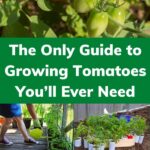

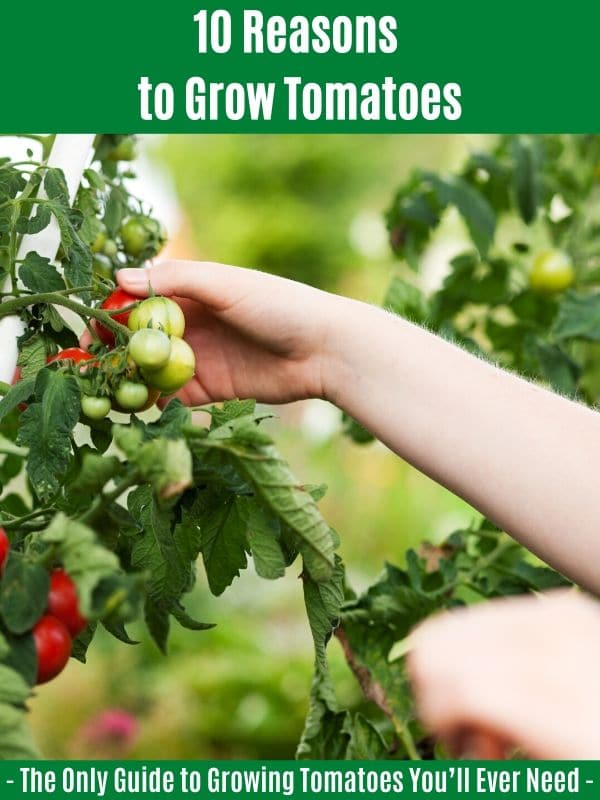
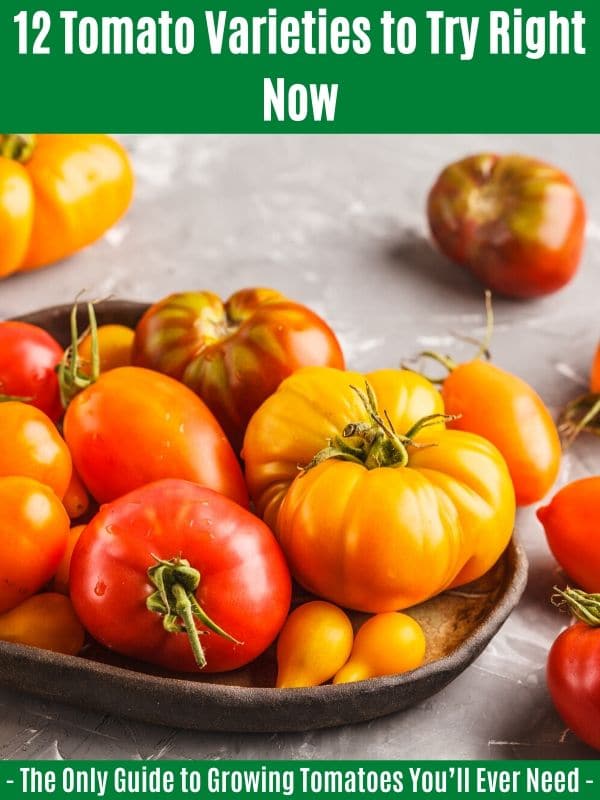
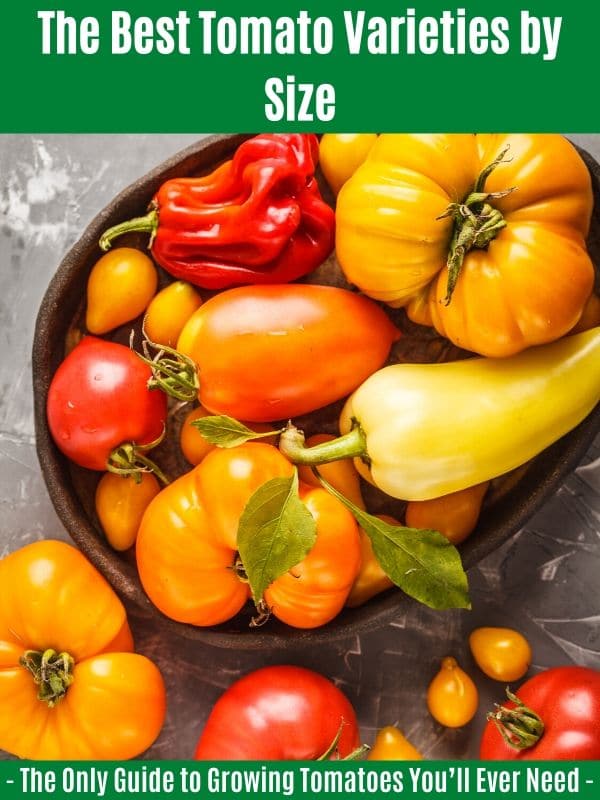
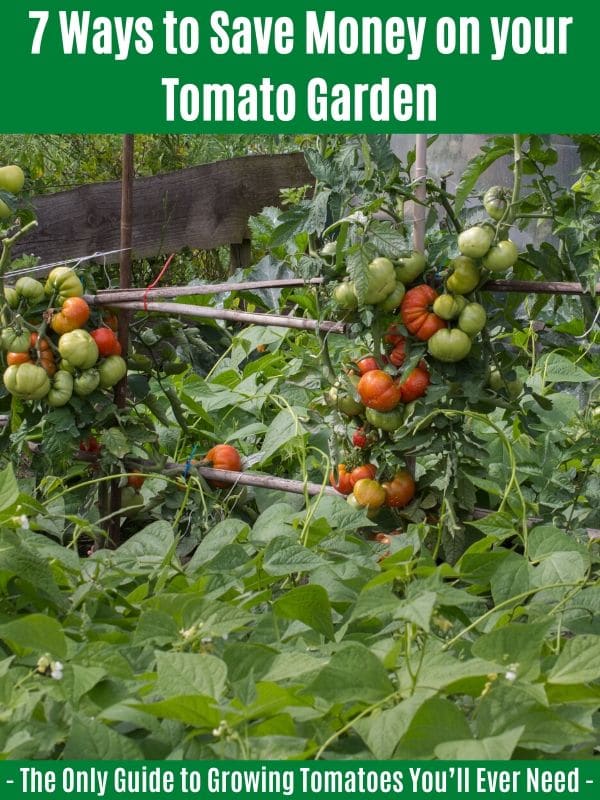
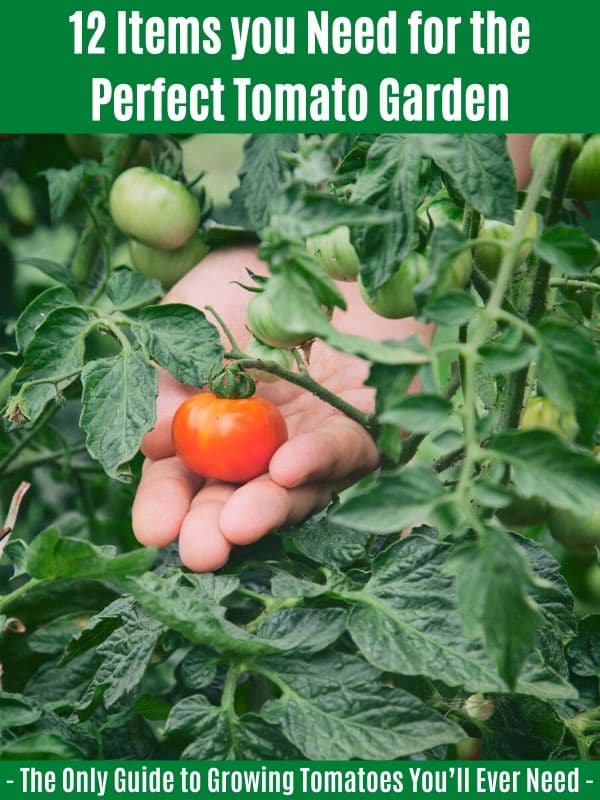
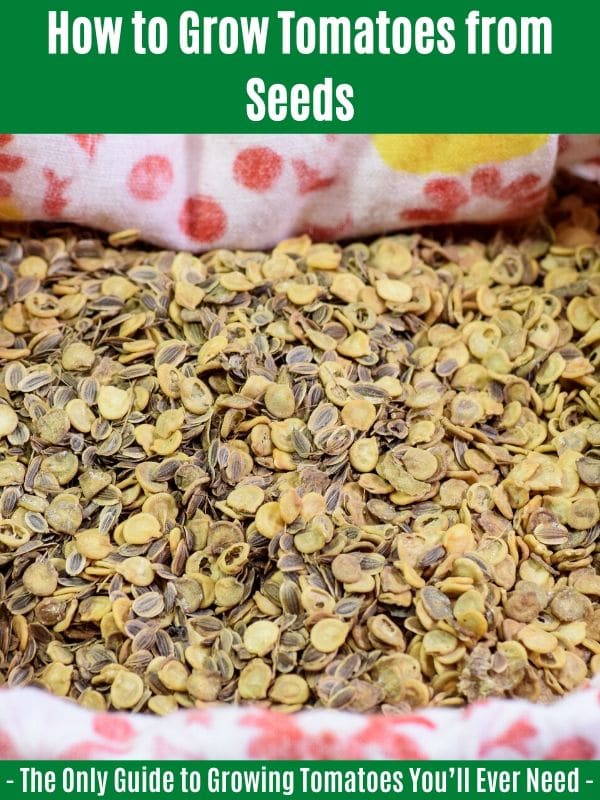
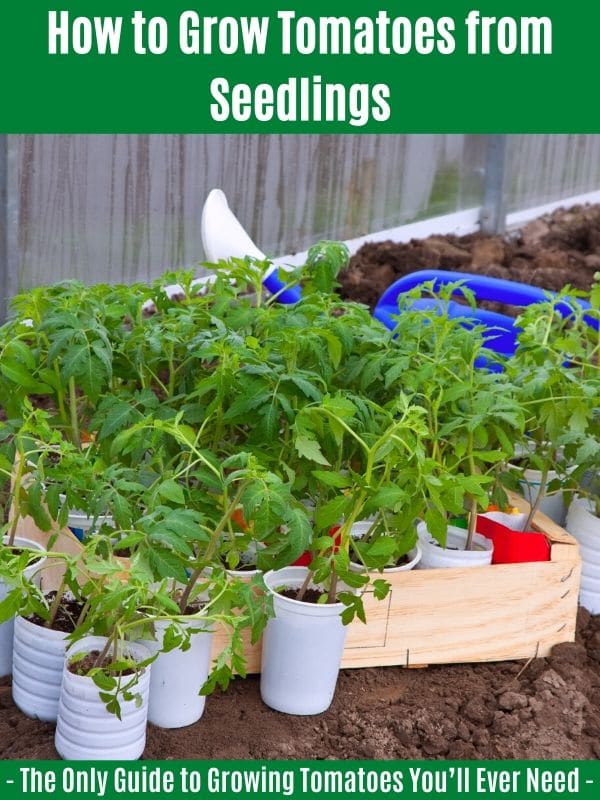
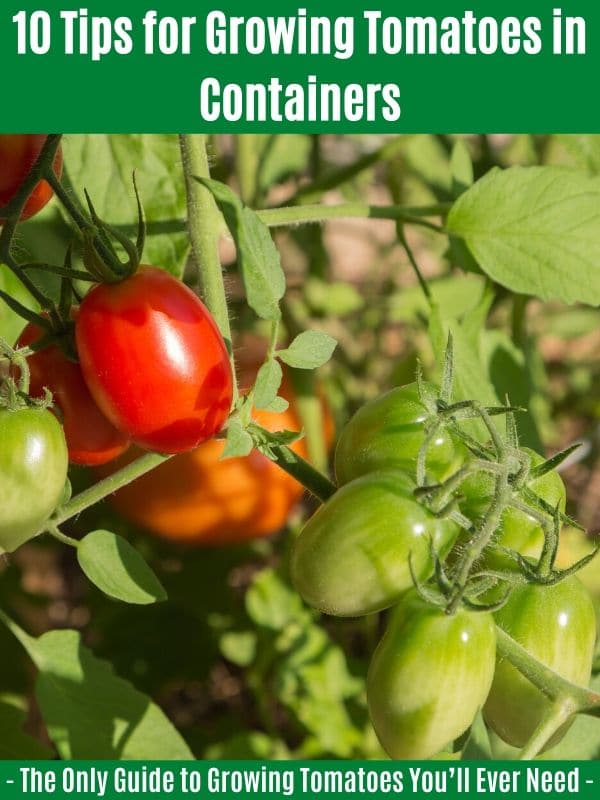
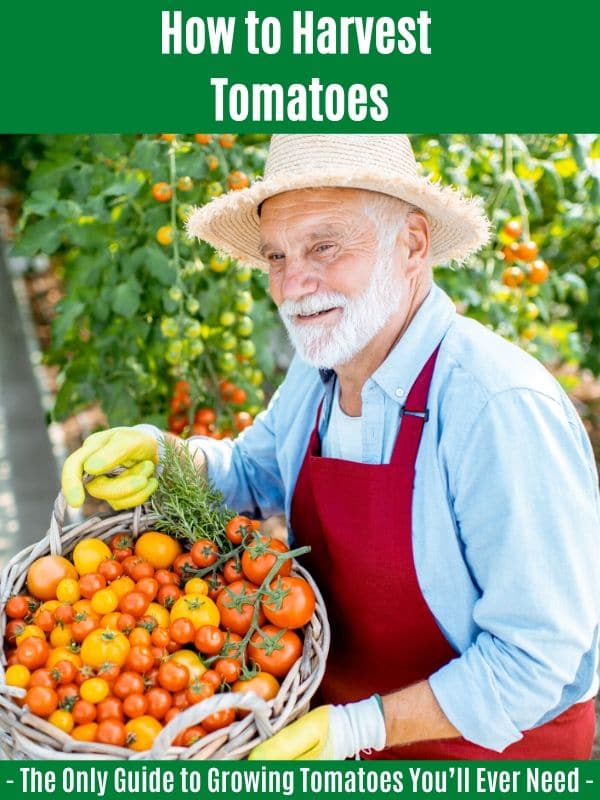
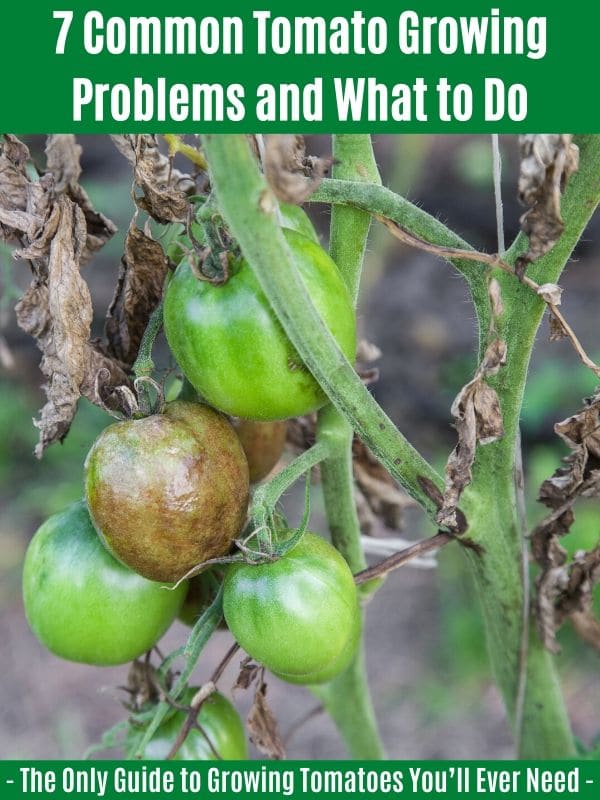
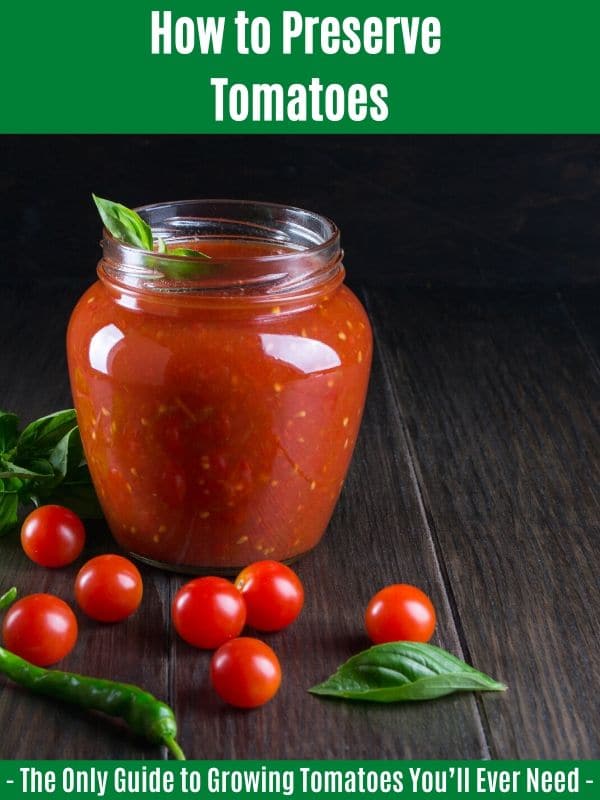
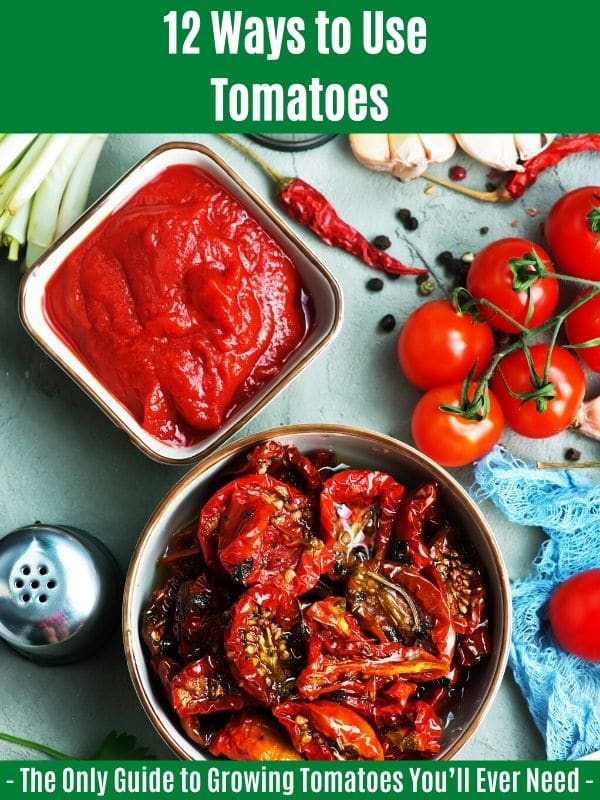


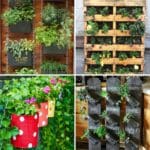

Leave a Reply